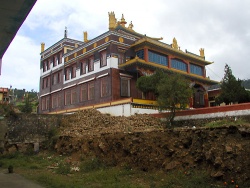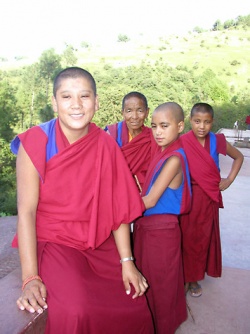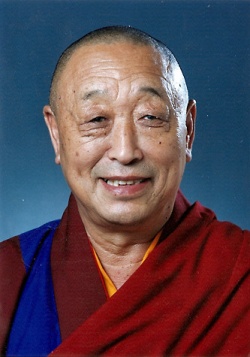Difference between revisions of "Menri Monastery"
| Line 12: | Line 12: | ||
[[Menri]] [[Monastery]] ([[Tibetan]]: {{BigTibetan|[[སྨན་རི་]]}}, [[Wylie]]: [[smanri]] — "[[Medicine]] mountain") is a [[Bon]] [[Monastery]] [[In Tibet]]. It was established in 1405 by Nyammey [[Sherab Gyeltsen]] ([[mnyam]] med [[shes rab rgyal mtshan]], 1356–1416), and became the leading [[Bon]] [[Monastery]] in the [[Tibetan]] {{Wiki|cultural}} region. The [[abbot]] of [[Menri]] is [[recognized]] as the [[Spiritual]] leader of [[Bon]]. [[Menri]] was destroyed by the {{Wiki|Communist}} {{Wiki|Chinese}} during the {{Wiki|Cultural Revolution}}, but has been rebuilt and is an active [[Monastery]] once again. | [[Menri]] [[Monastery]] ([[Tibetan]]: {{BigTibetan|[[སྨན་རི་]]}}, [[Wylie]]: [[smanri]] — "[[Medicine]] mountain") is a [[Bon]] [[Monastery]] [[In Tibet]]. It was established in 1405 by Nyammey [[Sherab Gyeltsen]] ([[mnyam]] med [[shes rab rgyal mtshan]], 1356–1416), and became the leading [[Bon]] [[Monastery]] in the [[Tibetan]] {{Wiki|cultural}} region. The [[abbot]] of [[Menri]] is [[recognized]] as the [[Spiritual]] leader of [[Bon]]. [[Menri]] was destroyed by the {{Wiki|Communist}} {{Wiki|Chinese}} during the {{Wiki|Cultural Revolution}}, but has been rebuilt and is an active [[Monastery]] once again. | ||
| − | In 1967, [[Menri]] was re-founded at [[Dolanji]] in [[Himachal Pradesh]], [[India]] by [[Lungtok | + | In 1967, [[Menri]] was re-founded at [[Dolanji]] in [[Himachal Pradesh]], [[India]] by [[Lungtok Tenpai Nyima]] and [[Lopon Tenzin Namdak]]. This [[Monastery]] has recreated the [[Geshe]] {{Wiki|training}} program, and is home to over two hundred [[Monks]]. [[Menri]] in [[India]] and [[Triten Norbutse]] [[Monastery]] in [[Nepal]] now host the only two [[Geshe]] programs in the [[Bon]] [[lineage]]. |
Latest revision as of 20:29, 21 December 2023
Menri Monastery (Tibetan: སྨན་རི་, Wylie: smanri — "Medicine mountain") is a Bon Monastery In Tibet. It was established in 1405 by Nyammey Sherab Gyeltsen (mnyam med shes rab rgyal mtshan, 1356–1416), and became the leading Bon Monastery in the Tibetan cultural region. The abbot of Menri is recognized as the Spiritual leader of Bon. Menri was destroyed by the Communist Chinese during the Cultural Revolution, but has been rebuilt and is an active Monastery once again.
In 1967, Menri was re-founded at Dolanji in Himachal Pradesh, India by Lungtok Tenpai Nyima and Lopon Tenzin Namdak. This Monastery has recreated the Geshe training program, and is home to over two hundred Monks. Menri in India and Triten Norbutse Monastery in Nepal now host the only two Geshe programs in the Bon lineage.
Education at Menri
Currently there are over 450 children including those from The Bon Children’s Home, the nunnery and the Monastery that are under the care and guidance of Menri. The number of refugee children arriving from Tibet and Nepal increase each year, with a great many of these children being orphaned. Children who attend The Bon Children’s Home for schooling may have both, or at least one parent alive, and sometimes that parent might have the resources to contribute financially for room and board, but more often than
not the parent has sent the child from Tibet or Nepal without financial recourse. For the children who are orphaned, His Holiness takes on the responsibility of full guardianship, which includes an Education through the 10th grade. When a young person finishes their 10th year of Education, they can choose to become a Monk or Nun. Families with the means pay for their
own son or daughters’ future monastic or secular higher Education. The orphaned aspiring Monk or Nun qualifies for sponsorship and remains under the responsibility of His Holiness. If they choose not to continue at the Monastery, they must leave and venture into secular Life. The Bon Future Fund was created to give financial support to
those students who pursue a secular higher Education. The YungDrung Bon Monastic Center, a non-profit organization located at Menri and maintained by a board of Monks, receives funds from The Bon Future Fund for those aspiring students’ further educational pursuits. The student then remains in contact with and provides progress reports to the YBMC.
Both girls and boys receive traditional training in Bon Religion and culture. Sutra, Tantra and Dzochen studies are taught in the traditional dialectic methods. Students engage in an in-depth study of Poetry, dance, Astrology, grammar, Thangka painting and Medicine. Life at the Monastery involves a living community; an
inner-connected and dependently woven tapestry of Compassion for the sacred and secular alike. The children tend to each other thoughtfully and show Respect for elders and one other. Life at the Monastery has a rhythm of Awareness that is palpable, where truly the sense of the sacred exists within the flow of every aspect of Life.
The Renla Menling Nunnery
Under the guidance and Leadership of His Holiness, much progress continues at Menri. The recent completion of the Renla Menling Nunnery is a wonderful example. Nestled in the other side of the valley, separated by a River, and connected by a newly
constructed road and bridge, rests the nunnery. It is the first of its’ kind in all of India for Bonpo Nuns and remains as one of the few in the entire World. Here young girls and women from Tibet, Nepal and India can now
receive a primary Education and have the potential to pursue secondary Education and monastic training. This is a major step in creating equal educational opportunities for both boys and girls, reflecting a positive outlook for the future of Bon both culturally and spiritually.
His Holiness Lungtok Tenpa’I Nyima, 33rd Abbot of Menri
His Holiness Lungtok Tenpa’I Nyima serves as the 33rd Abbot of Menri and is the worldwide Spiritual head of the Bon Religion of Tibet. He was born in 1927 in the far eastern province of Amdo, in the village of Kyongstang,Tibet.
When still a little boy, his mother died and an elderly friend of the family, A-Nyen Machen, offered to raise him. At the age of 8, his father, Jalo Jongdong brought him to the nearby Monastery of Phuntsog Dargye Ling where he began preliminary studies such as reading, Writing and Chanting. He continued with his studies and at the age of sixteen he entered the Dialectic School at the Monastery. After eight years of rigorous training under the guidance of Lopon Tenzin Lodro Gyatso, he received his Geshe degree in philosophy, specializing in Tibetan Medicine, astronomy and Astrology.
Soon after, at the age of 26, he traveled to eastern Tibet to the province of Gyalrong to print the Bon Kangyur, a set of over 100 volumes of Sacred Texts. The texts existed on woodblock, and were kept by the king Trochen Gyalpo, one of the eighteen kingdoms of Gyalrong. Using mules to carry the vast amount of printed texts, he then made the perilous six-month journey back to Phuntsog Dargye. Soon after his return, he set out as a pilgrim to China, on foot. He visited many holy sites and
traveled to central Tibet in the Tsang province, furthering his studies in the Bon Monasteries of Khana, Menri and Yungdrung Ling , where he became known as Sangye Tenzin Jongdong. By truck, he made the journey to the Drepung Monastery in Lhasa where he stayed for several years until the 1959 uprising. He fled on foot to Mustang, on the boarder of Tibet and
Nepal, then to Nepal. Hearing word that the Abbot of Yung Drung Ling Monastery and many Bonpo lamas had reached the Bon Monastery of Samling, he went to join them. Coincidently, Dr. David Snellgrove, a researcher of Oriental and African studies from London University was doing research at Samling.
Prompted by the urgent need to preserve as many of the Bon texts and woodblocks as possible, this fortuitous meeting of Dr. Snellgrove provided him with the Information as to where the texts could be reprinted in India. So he and the Abbot of YungDrung Ling set out to India from Nepal with mules laden with the precious cargo. Once there, with the help of Samten Gyaltson Karmay and Lopon Tenzin Namdak the texts were reprinted.
In 1962, Dr Snellgrove, with a grant from the Rockefeller Foundation, invited the three men to come to England,where they taught Tibetan culture and Religion as assistants to Dr. Snellgrove.
Sange Tenzin JongDong stayed in England for three years, visiting and studying at a number of Benedictine, Cistercia, and other Christian Monasteries and in 1964, he traveled to Rome and received a private audience with Pope Paul VI. Later
that same year he returned to India, and at the request of the His Holiness the 14th Dalai Lama, started a school staffed with volunteer teachers from the West in Massori, Northern India. The school provided a high school Education for Tibetan refugee boys who had completed the 8th grade. He remained as the head of the school for nearly three years, each month sending his salary of 300 rupies to the refugee Bonpo lamas living in Manali, India so that they could have Food.
With the help of the Catholic Relief Service, in New Delhi, Lopon Tenzin Namdak was able to purchase some land in the Himachal Pradesh region in India, establishing Dolanji as the new home for the Tibetan Bonpo refugee community. At the invitation of the Tibetan scholar Per Kvaerne, Sangye Tenzin Jongdong traveled to Norway to teach history and Religion at the University of Oslo.
It was when he was in Norway, on March 15th 1968 when he received a telegram from India which stated that the Protectors of Bon had selected him to be the 33rd Abbot of Menri.


